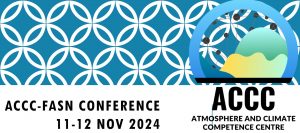Project Description

The Atmosphere and Climate Competence Center (ACCC) – Finnish Atmospheric Sciences Network (FASN) Conference (https://en.ilmatieteenlaitos.fi/accc-fasn2024) took place onsite during 11-12 Nov 2024 (Helsinki, Finland). It has been jointly organized by the University of Helsinki and the Finnish Meteorological Institute. More than 200 participants attended the conference.
On Monday, 11 Nov 2024, the conference included two oral sessions and the poster session on evening. The first session on “Quantifying and activating the potential of land-based climate change mitigation” took place in the morning, and started from a plenary talk on “Atmosphere-biosphere feedbacks: matching puzzle pieces”, followed by presentations from contributing speakers about: barley monoculture vs. barley with undersown species: impact of diversity on green-house gases (GHG) exchange in Finland; effect of extreme weather on peatland GHG exchange in future climate using JSBACH-HIMMELI ecosystem model; new particle formation (NPF) in Milan: an investigation about the role of meteorological conditions and urban pollution; review of the European Union Carbon Removals and Carbon Farming Certification (CRCF) Regulation; quantifying uncertainty in carbon dioxide removal with Gaussian process emulators and Markov Chain Monte Carlo; optimizing forest carbon sinks. The session continued with a plenary talk on “Climate change attribution of extremes and their impacts in Finland”, followed by presentations about role of bark in tree survival under drought stress; ecological restoration of low-productive peatlands drained for forestry; effect of urbanization of the Chinese gigacity on the water and energy balances; severe haze episodes in Beijing may have origins as far as 2000 km west; new guidance documents on advanced air quality parameters by RI-URBANS.
The second session took place with presentations about characterization of water-soluble inorganic ions and carbo-naceous aerosols in the urban atmosphere in Amman, Jordan; prediction of droplet size distribution ruptured from lung airways using numerical simulations; satellite observations to support air quality monitoring in East Africa; potential of satellite observations to advance our understanding of atmospheric methane in the Arctic. The poster session (during 16-18 pm) had more than 80 posters covering different topics of the conference, and it followed by the conference dinner.
On Tuesday, 12 Nov 2024, the third session on “Climate change impacts and adaptation” took place in the morning, starting from a plenary talk on “What do we know, and do not know, about the fate of permafrost nitrogen following thaw?”, and followed by presentations about transformative climate change education in art-science collaboration; targeted metagenomics using probe capture detect a larger diversity of nitrogen and methane cycling genes than traditional metagenomics – do nitrogen cycling microbes play a role in plant tissues?; evaluating and optimising integration between climate and air pollution policies: the ClimAirPathways approach; effects of a long-term water level drawdown on phototrophic communities and photosynthesis in boreal peatlands; role of the European Scientific Advisory Board on climate change; xylem conduits and inter-conduit pits of Scots pine, Norway spruce and Silver birch scale in a coordinated way with distance from the treetop.
The fourth session on “Quantifying the air quality – climate interactions and their impacts” started with a plenary talk on “Emissions beyond greenhouse gases: exploring how they shape our one atmosphere”, followed by presentations about satellites capture socioeconomic disruptions during the 2022 full-scale war in Ukraine; Multi-Pressure Chemical Ionization Mass Spectrometry for the analysis of complex gas mixtures; Wintertime brown carbon characterization: understanding chemical composition and light absorption in residential and traffic areas; Nuclear observations to improve climate research and GHG emission estimates – NuClim; Linking sulphur dioxide, sulfuric acid, clusters, and small particles: implications for future particle formation events; Could contrail properties change when commercial aircraft use Sustainable Aviation Fuel instead of standard JET A-1 fuel?; Deposition ice nucleation on silica particles via an adsorption-freezing mechanism; Estimating global accumulation-mode particle number concentrations with machine learning and reanalysis data; new atmospheric measurement site in northern Botswana; effect of noise barriers on air quality using PALM model; quantifying the contributions of new particle formation and traffic emissions on urban ultrafine particle concentrations; examining the role of sedimentation in modulating ice nucleation pathways in cirrus clouds; Accretion products for probing RO2 chemistry; preliminary summary of Urbaani ilmanlaatu 2.0 project; Cluster Ion Counter: a tool to investigate local new particle formation and condensation sink.
During the conference the outcomes of the Horizon 2020 research projects RI-URBANS (https://riurbans.eu) and CRiceS (https://www.crices-h2020.eu) as well as the Erasmus+ educational projects ClimEd (http://climed.network) and CLUVEX (https://www.atm.helsinki.fi/cluvex) were also presented, and where the PEEX is actively involved also with dissemination of results.
See detailed conference programme: https://en.ilmatieteenlaitos.fi/accc-fasn-programme
See detailed list of posters
See the Abstract Book of the ACCC-FASN Science Conference 2024
Text by: Hanna Lappalainen, Tuukka Petaja, Alexander Mahura (Univ of Helsinki, INAR)
